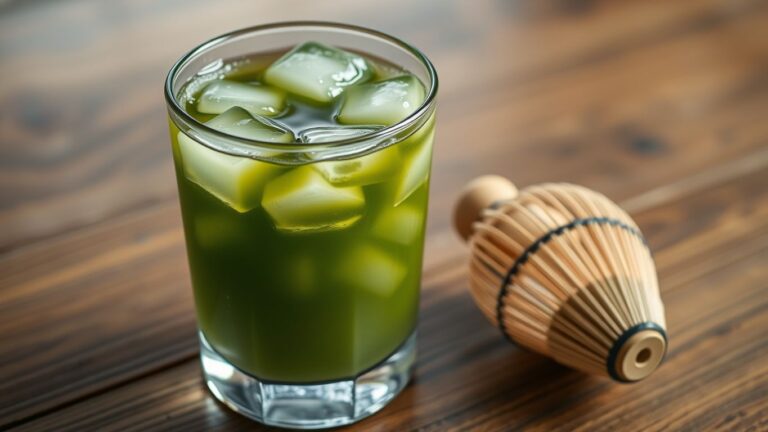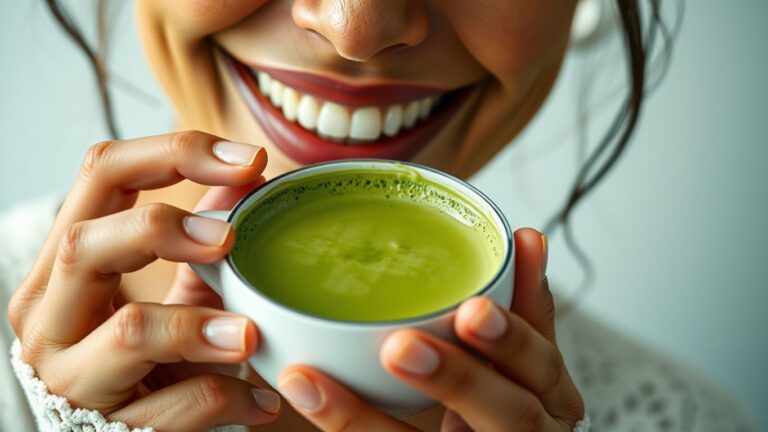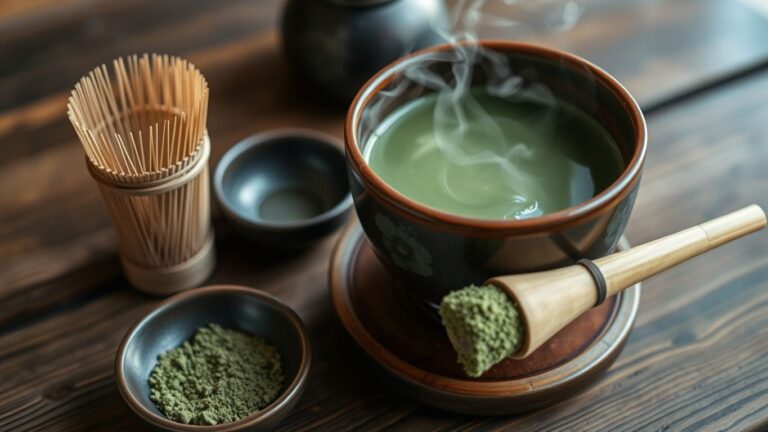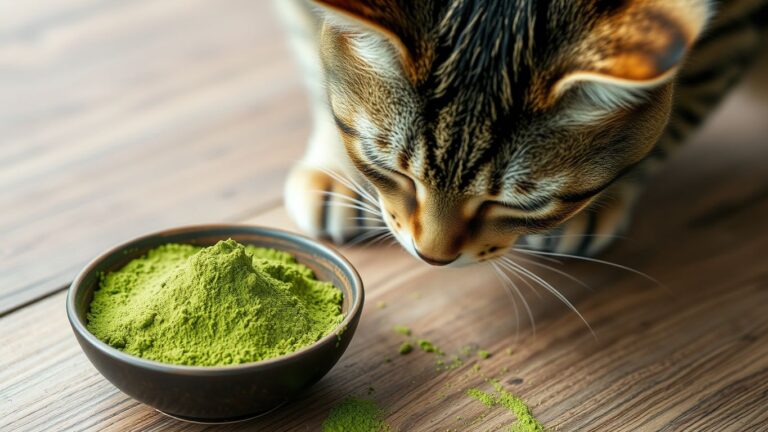Matcha, the bright green tea powder from Japan, has become a favorite for many around the world. Its unique flavor profile sets it apart from other teas. But what exactly does matcha taste like? In this article, we’ll explore the different taste components that make matcha so special.
Key Takeaways
- Matcha has a rich umami flavor, giving it a savory taste that’s hard to find in other teas.
- The natural sweetness in matcha comes from its amino acids, which balance its slight bitterness.
- Earthy tones in matcha come from its high chlorophyll content, providing a vegetal taste.
- The creamy texture of matcha, especially when whisked well, enhances its overall flavor experience.
- Different preparation methods and matcha grades can significantly affect its taste and texture.
The Umami Sensation in Matcha

Understanding Umami
When you take a sip of matcha, one of the first things you’ll notice is its rich, savory umami flavor. Umami, often called the fifth taste, adds depth and complexity to the tea. This unique taste is a result of the shade-growing process, which increases the amino acid content, especially L-theanine, giving matcha its signature flavor.
How Shade-Growing Enhances Umami
The process of growing matcha in the shade is crucial for developing its umami taste. By blocking sunlight, the tea plants produce more chlorophyll and amino acids, particularly L-theanine. This not only gives matcha its vibrant green color but also enhances its savory, umami flavor.
Comparing Umami in Matcha to Other Foods
Matcha’s umami flavor is often compared to the subtle earthiness found in foods like shiitake mushrooms or soy sauce. However, in matcha, this taste is more delicate and tea-like. The umami in matcha provides a unique, savory complexity that sets it apart from other teas and foods.
Sweetness in Matcha: A Delicate Balance
Natural Sweetness from Amino Acids
Unlike other green teas, matcha carries a natural sweetness that lingers on the palate. This sweetness is intensified during matcha’s unique shading process. The combination of umami and sweetness creates a harmonious flavor profile, making matcha a delightful beverage for those with a sweet tooth. For maximum sweetness, we recommend Ceremonial Grade matcha.
Balancing Sweetness and Bitterness
While matcha leans towards sweetness, it can also carry a subtle bitterness. The bitterness is usually a result of factors such as the tea’s quality, preparation method, and personal preference. When prepared correctly, the bitterness is minimal and complements the other flavors, creating a well-balanced cup of tea. For bold matcha flavors that can cut through other ingredients, we recommend Culinary Grade matcha.
Sweetness in Ceremonial vs. Culinary Matcha
Ceremonial Grade matcha is known for its mellow sweetness and rich umami flavor, making it ideal for traditional tea ceremonies. On the other hand, Culinary Grade matcha, while still sweet, has a more pronounced bitterness, making it suitable for cooking and baking. The choice between the two depends on how you plan to use the matcha and your personal taste preferences.
The Earthy Undertones of Matcha

Chlorophyll’s Role in Earthiness
The earthy undertones in matcha come from its high chlorophyll content. When tea plants are grown in the shade, they produce more chlorophyll, giving matcha its vibrant green color and earthy flavor. This process not only enhances the tea’s nutritional value but also contributes to its unique taste.
Vegetal Notes in Matcha
Matcha has distinct vegetal notes, often compared to the taste of spinach or young grass. These flavors are a result of the freshly harvested, young tea leaves used to make matcha. The vegetal notes add to the tea’s character, providing a grounded and refreshing experience.
Earthiness Across Different Matcha Grades
The level of earthiness in matcha can vary depending on its grade. Ceremonial grade matcha, made from the youngest tea leaves, tends to have a more subtle earthy flavor. In contrast, culinary grade matcha, which uses older leaves, has a stronger, more pronounced earthiness. This difference in flavor makes each grade suitable for different uses, from traditional tea ceremonies to cooking and baking.
Bitterness in Matcha: Friend or Foe?
Why Some Matcha Tastes Bitter
Bitterness in matcha can be a double-edged sword. While some people enjoy strong, powerful flavors, others might find it off-putting. The bitterness often comes from lower-quality matcha or improper preparation. High-quality ceremonial matcha usually has a milder bitterness, balanced by sweetness and umami.
How to Minimize Bitterness
To reduce bitterness, use cooler water, around 80 degrees Celsius, and whisk the matcha properly. You can also try adding a sweetener like honey or mixing it with milk to create a matcha latte. These methods can help balance the flavors and make the bitterness less noticeable.
Bitterness in High-Quality vs. Low-Quality Matcha
High-quality matcha, like ceremonial grade, has a more balanced flavor profile with minimal bitterness. In contrast, lower-quality matcha, often labeled as culinary grade, tends to be more bitter and is best used in recipes where other ingredients can mask the bitterness. If you enjoy strong, powerful flavors, you might still appreciate the bold taste of culinary matcha.
The Creamy Texture of Matcha
Achieving the Perfect Froth
Creating the perfect froth is essential for a creamy matcha experience. Start by whisking the matcha powder with hot water using a bamboo whisk. A quick "W" or "M" shaped motion helps to evenly distribute the matcha and create a frothy layer. The foam adds to the texture of matcha, rounding it off and giving it an aromatic, light, creamy mouthfeel.
Texture Differences in Preparation Methods
The texture of matcha can vary depending on how it’s prepared. Traditional methods often result in a thicker, more concentrated drink, while modern techniques can produce a lighter, smoother texture. For example, matcha lattes tend to be creamier due to the addition of milk, whereas a traditional tea ceremony preparation will focus on achieving a fine, frothy consistency.
How Texture Affects Flavor Perception
The texture of matcha significantly impacts how you perceive its flavor. A creamy, well-frothed matcha can enhance the natural sweetness and umami, making each sip more enjoyable. On the other hand, a poorly whisked matcha may taste more bitter and less balanced. The velvety consistency of a well-prepared matcha elevates the overall drinking experience, making it a luxurious treat for your senses.
Comparing Matcha to Other Teas

When you think about matcha, you might wonder how it stacks up against other teas. Let’s dive into the unique qualities that set matcha apart from green tea and black tea.
The Role of L-Theanine in Matcha’s Flavor
What is L-Theanine?
L-Theanine is an amino acid found in tea leaves, especially in matcha. This compound is known for its calming effects and its ability to enhance focus. When you drink matcha, the L-Theanine works together with caffeine to give you a calm alertness, unlike the jittery feeling you might get from coffee.
L-Theanine and Umami
The umami flavor in matcha is partly due to its high L-Theanine content. This amino acid contributes to the savory, rich taste that makes matcha unique. The shade-growing process of matcha increases the levels of L-Theanine, making the umami flavor more pronounced compared to other teas.
L-Theanine’s Impact on Sweetness
L-Theanine also plays a role in the natural sweetness of matcha. It balances out the bitterness, making the tea more palatable. This is why high-quality matcha, which has more L-Theanine, often tastes sweeter and less bitter. Different types of green tea, such as matcha and gyokuro green tea, have been studied to have large, natural concentrations of L-Theanine and caffeine, enhancing their flavor profiles.
How Preparation Methods Affect Matcha’s Taste
Traditional Japanese Tea Ceremony
The traditional Japanese tea ceremony is a ritual that brings out the best in matcha. Using a bamboo whisk, you create a smooth paste by whisking matcha and hot water in a "W" or "M" motion. This method ensures an even distribution of matcha, resulting in a creamy texture and vibrant green color. The ceremony emphasizes mindfulness, allowing you to savor each sip and experience the subtle sweetness, gentle bitterness, and lingering umami.
Modern Preparation Techniques
Modern techniques offer a variety of ways to enjoy matcha. You can blend matcha with creamy bases like almond or oat milk for a delicious latte. Adjusting the matcha quantity and incorporating sweeteners can also enhance the flavor. These methods are perfect for those who prefer a quick and easy preparation without compromising on taste.
Cold Brew vs. Hot Brew Matcha
Cold brew and hot brew matcha offer different flavor profiles. Cold brew matcha is made by mixing matcha powder with cold water and letting it steep for several hours. This method results in a smoother, less bitter taste. On the other hand, hot brew matcha involves whisking matcha with hot water, which can bring out a more intense flavor. Both methods have their unique qualities, allowing you to choose based on your taste preferences.
The way you prepare matcha can significantly impact its flavor, making it essential to find a method that suits your taste.
Key Factors to Consider
- Water Temperature: Keep it at a maximum of 175°F (80°C) to avoid bitterness.
- Matcha-to-Water Ratio: Adjust based on whether you prefer a thicker or thinner consistency.
- Whisking Technique: A proper whisking technique can create a frothy, creamy texture.
By experimenting with different preparation methods, you can discover the perfect way to enjoy matcha’s unique flavor.
The Influence of Matcha’s Origin on Flavor
Regional Differences in Japanese Matcha
Matcha’s flavor can vary greatly depending on where it is grown in Japan. Different regions have unique soil compositions and climates, which influence the taste. For example, matcha from Uji is known for its rich umami flavor, while matcha from Shizuoka might have a more vegetal taste.
How Soil and Climate Affect Taste
The soil and climate where matcha is grown play a crucial role in its flavor profile. Rich, nutrient-dense soil can enhance the sweetness and umami of the tea. On the other hand, harsher climates might result in a more bitter taste. The balance of these elements creates the unique flavors found in matcha from different regions.
Famous Matcha-Producing Regions
Japan has several famous matcha-producing regions, each known for its distinct flavor profile:
- Uji: Renowned for its deep umami and smooth texture.
- Nishio: Known for its bright green color and balanced taste.
- Shizuoka: Offers a more vegetal and slightly astringent flavor.
These regions have perfected the art of growing matcha, making them highly sought after by tea enthusiasts worldwide.
Pairing Matcha with Foods

Matcha’s unique flavor makes it a great match for many foods. Its balance of sweetness and bitterness allows it to pair well with both sweet and savory dishes. Here are some ideas to get you started.
The Evolution of Matcha’s Flavor Over Time
Historical Changes in Matcha Cultivation
Matcha has a long history that dates back to ancient China during the Tang Dynasty (618-907 CE). Initially, tea lovers steamed green tea leaves and ground them into a fine powder. However, it was in Japan that matcha truly evolved. The Japanese Zen Buddhist monk Eisai brought matcha seeds to Japan in the late 12th century, planting them in Kyoto. Over time, the cultivation and processing techniques were refined, resulting in the unique flavor profile we enjoy today.
Modern Innovations in Matcha Production
In recent years, modern innovations have further enhanced matcha’s flavor. Techniques such as improved shading methods and advanced grinding technology have allowed for a more consistent and vibrant product. These innovations ensure that the matcha you drink today is of the highest quality, with a rich umami flavor and a delicate balance of sweetness and bitterness.
Future Trends in Matcha Flavor
Looking ahead, the future of matcha flavor is exciting. As global interest in matcha continues to grow, producers are experimenting with new cultivation methods and flavor profiles. You can expect to see matcha with even more nuanced flavors, catering to a variety of palates. The evolution of matcha is far from over, promising a bright future for this beloved green tea.
Conclusion
In conclusion, matcha offers a truly unique and captivating flavor experience. Its rich umami taste, combined with subtle sweetness and a hint of bitterness, creates a balanced and complex profile that is unlike any other tea. Whether you’re enjoying a traditional ceremonial grade or a versatile culinary grade, the depth of flavor in matcha is sure to leave a lasting impression. So, if you haven’t tried matcha yet, now is the perfect time to explore this vibrant green tea and discover its delightful taste for yourself.
Frequently Asked Questions
What is matcha?
Matcha is a type of green tea that comes in powdered form. Unlike regular green tea, where you steep the leaves, matcha is made by grinding whole tea leaves into a fine powder. This means you consume the entire leaf, getting more nutrients and a stronger flavor.
Why does matcha taste different from regular green tea?
Matcha tastes different because it is grown and processed differently. The tea plants are grown in the shade for several weeks before harvest, which increases their chlorophyll and amino acid content. This results in a richer, more complex flavor with sweet, savory, and earthy notes.
Is matcha supposed to be bitter?
High-quality matcha should have a balanced flavor with only a slight bitterness. If your matcha is very bitter, it might be of lower quality or not prepared correctly. Properly whisked, high-grade matcha should taste smooth and pleasant.
What does umami mean in relation to matcha?
Umami is one of the five basic tastes, often described as savory or meaty. In matcha, umami adds depth and richness to the flavor, making it more complex and enjoyable.
How can I reduce the bitterness in matcha?
To reduce bitterness, use high-quality matcha and whisk it properly. You can also try adding a sweetener like honey or blending it with milk to make a matcha latte. Using cooler water (around 175°F) instead of boiling water can also help.
Does all matcha taste the same?
No, not all matcha tastes the same. The flavor can vary based on the quality, origin, and how it’s prepared. Ceremonial grade matcha is usually sweeter and more delicate, while culinary grade matcha is more robust and slightly more bitter.
Can matcha be used in cooking?
Yes, matcha can be used in cooking and baking. Culinary grade matcha is perfect for recipes like smoothies, lattes, cakes, and cookies. It adds a unique flavor and vibrant green color to dishes.
How should matcha be stored to maintain its flavor?
To keep matcha fresh, store it in an airtight container in a cool, dark place. Exposure to air, light, and heat can make it lose its flavor and vibrant color. Refrigeration can also help extend its shelf life.






